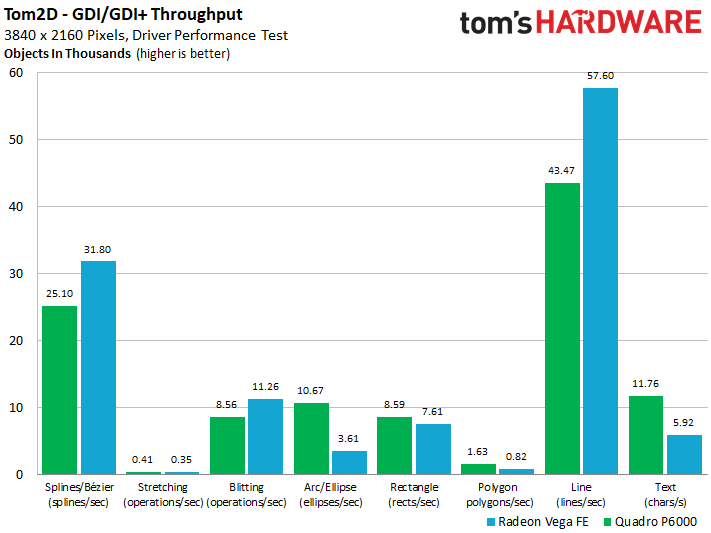AMD Radeon Vega Frontier Edition 16GB Review
Why you can trust Tom's Hardware
2D Workstation Performance
Workstation Benchmarks Preamble
There are several reasons for including Nvidia's Quadro P6000 in this comparison, as opposed to the Titan Xp or GeForce GTX 1080 Ti. Beyond what we discussed in our intro, even in the semi-professional field, a monitor with 10-bit color depth is not optional. Consequently, we’re using an Eizo EV3237-BK, and not just any old gaming monitor.
Both the Quadro P6000 and Radeon Vega FE offer this feature for DirectX and the OpenGL overlay. Using a Titan Xp instead for certain applications would certainly be great, but its drivers just don’t support OpenGL overlay at 10-bit color depth. So, in our comparison, we’re just using the Radeon Vega FE the way that it was intended to be used.
Driver Throughput For Direct Monitor Output
Since graphics cards started using a unified shader architecture, dedicated 2D functions have vanished. With the sole exception of directly copying bitmaps, any and all hardware acceleration disappeared with Microsoft’s Windows Vista. This means that everything, no matter how small, needs to make its way through the driver to D3D. That gives us an excellent opportunity to test AMD's driver.
For each of the common graphics functions, we set a time during which as many objects as possible are drawn to the output device. The objects and their order are affected by a random number generator to avoid caching effects. However, its start is set to the same place every time, so all of the benchmark runs are ultimately identical. All geometrical objects have a colored contour line and their area is filled at random.
It’s plain to see where AMD needs to catch up. Some of the categories are okay, but when it comes to rendering texts, polygons, ellipses, and circles, the Radeon Vega FE doesn’t fare as well. Conversely, there are also bright spots where AMD beats Nvidia's Quadro: lines and splines, as well as blitting.
Incidentally, some of these tasks can result in a very high CPU load, since parts of each computation require work from the host processor. So, some of what we're seeing could be attributable to driver overhead.
Driver Throughput For Direct Monitor Output
Our second set of benchmarks employs a different approach. The content stays the same, but now we’re drawing to a virtual bitmap located in system memory, and then having it all copied to the graphics memory in one go. Doing this amplifies AMD’s issues.
Get Tom's Hardware's best news and in-depth reviews, straight to your inbox.
Drawing polygons is the Radeon Vega FE’s biggest weakness at this point in time. It reaches just 11 percent of the Quadro P6000’s performance. AMD has a lot of catching up to do in this discipline, especially since these types of virtual bitmaps are popular for moving graphical elements in real-time.
These first two benchmarks don’t specifically relate to, say, CAD performance. However, we do know there are tasks that can be optimized at an application level by implementing special functions responsible for intercepting certain objects or changing how they are rendered. These types of optimizations usually take a lot of time and effort. This is why they are only part of the Radeon Pro and Quadro drivers, which contributes to making the professional graphics cards more expensive.
AutoCAD 2017 - 2D Performance
Speaking of CAD, now we're having AutoCAD output large 2D workloads. Performance in this area’s largely limited by the CPU, which means that the differences between the graphics cards are smaller than you might expect. It doesn’t really matter which card is being used for 2D rendering exclusively, so long as it has lots of memory. Even lower-end cards like Nvidia's Quadro P2000 achieve a respectable 130 points.
MORE: Best Graphics Cards
MORE: Desktop GPU Performance Hierarchy Table
MORE: All Graphics Content
Current page: 2D Workstation Performance
Prev Page Board Layout & Components Next Page 3D Workstation Performance
Igor Wallossek wrote a wide variety of hardware articles for Tom's Hardware, with a strong focus on technical analysis and in-depth reviews. His contributions have spanned a broad spectrum of PC components, including GPUs, CPUs, workstations, and PC builds. His insightful articles provide readers with detailed knowledge to make informed decisions in the ever-evolving tech landscape




